
Mobiblu DAH-220 MP3 player
Review date: 22 February 2005.Last modified 03-Dec-2011.
Basic MP3/WMA players are commodity items these days.
They don't necessarily sound great (their bundled headphones are invariably craptacular, and they can have a hard time driving proper headphones, too), but they're so cheap that a lot of people go out to buy a USB "thumb drive" and end up coming home with one that can also play music. Or get a player free with their mobile phone plan. The things are on sale in discount stores now, for heaven's sake; they'll be in cereal boxes next week.
Practically all of these things have an integrated microphone and voice record function, which often works surprisingly well as long as the player's interface doesn't make record/pause/stop operations each take ten seconds. Many of them also have FM radio tuners (but never an AM tuner, presumably for combined chipset/space-for-rod-antenna reasons). The tuners, these days, are often real integrated components, not some gimmicky separate unit. And, unlike the bad old days when digital cameras and MP3 players could only talk to computers through some piece of proprietary software, the modern versions all work as USB Mass Storage Devices; you just plug 'em into a current Windows PC or Mac (or, probably, Linux box) and they turn up as a removable drive.
That's about where the generic MP3 player feature set stops, though.
This thing does so much more.
Dedicated geeks will, at a glance, recognise the class of gadget into which the Mobiblu DAH-220 fits. Normal humans will need some further explanation.
What it is, you see, is an MP3 player/recorder built into a "cassette adapter" shell.
The person who came up with the cassette adapter must have been pretty darn pleased with themselves. The idea's simple enough; install a stereo set of electromagnetic heads...
...in a regular compact cassette shell, so that the heads in the shell will line up with the heads of a cassette deck. Now you've got a gadget that's neatly inductively coupled to the heads of the deck; you can feed it a plain un-fiddled-with headphone level signal and it'll transfer it, with quite high fidelity, to the cassette deck, which'll think it's playing a tape. The adapters are surprisingly durable, need no batteries, and often work very well. Huge numbers of the things have been sold to people who want to hook up their CD or MP3 player, or whatever, to a basic car stereo that's got no line in socket, but does have a cassette slot. The wire for the adapter comes out of a corner nearest the opening of a car cassette deck (and any other deck with a slot-load design); you can use adapters in regular cassette decks as well, but may have to snip a bit out of the door to let the wire through.
Cassette adapter sound fidelity isn't as good as a direct cable connection to the pre-amp, but they generally sound quite a lot better than the common alternative - a flea-power FM transmitter that you strap onto your sound source, then tune the car radio to. Cassette adapters, in particular, often sound noticeably better than real cassettes - no tape means no tape hiss, and because the speed of the tape transport doesn't affect the signal, there's no wow or flutter either.
About five years ago, someone first managed to shoe-horn the guts of an MP3 player into a cassette adapter shell. The result was the RomeMP3, which has now faded into the mists of history; the Rome domain now belongs to one of those useless squatting companies. Anyway, the original RomeMP3 offered a lousy 32Mb of memory, cost $US199, and had some other personality traits that did not endear it to reviewers.
(OK, maybe the typographically peculiar Hit C@mp came out before the Rome; I'm not sure. It wasn't very exciting either, though.)
There've been a few other cassette MP3 units since then, the most notable of which is the Digisette Duo-DX. The Duo-DX has been around for quite a while, now; back in 2002, it'd set you back $US189.
The Duo-DX looks remarkably like the Mobiblu product. Very remarkably. It would appear that the same actual manufacturer makes both devices; perhaps some exclusive license ran out, or something, and that's why we're seeing the thing under the Mobiblu brand now. Fortunately, though, the DAH-220 has had some considerable updates.
It's also cheaper. Here in Australia, the DAH-220 cost $AU236.50 from Aus PC Market, including delivery anywhere in the country, when I wrote this review in early 2005. The exchange rate then made that price about the same as the old US price for the Duo-DX, but the Mobiblu player's got better specs.
Aus PC Market don't sell the DAH-220 any more, and other dealers seem to be out of stock as well. Note, for your dealer-searching convenience, that there's also a DAH-225 version of this player, which seems to be so similar to the DAH-220 that Mobiblu never bothered a separate product page for it. Apart from that, though, you're on your own.
Feature list
OK - so what's the same, and what's different?
Here's the whole Mobiblu kit.
Both the Digisette and the Mobiblu versions of this player have an aluminium casing, which makes them tough and pleasingly weighty - the DAH-220's 72.5 grams (2.56 ounces), with battery, according to my trusty Ohaus).
Both players have a teeny USB port hiding on their bottom edge; if they were real cassettes, you'd have to stab the USB lead through the tape to plug it in.
The old Digisette, though, only has 96Mb of built-in memory. The DAH-220 officially has 256Mb; its actual formatted capacity is 247Mb. That's more than three and a half hours of 160 kilobit per second MP3s.
The USB transfer rate for the Mobiblu player is below half a megabyte per second; its updates do not include a USB 2 interface. It'll take less than ten minutes to fill the whole 247Mb, though, so the slow transfer rate isn't terribly painful.
Both players have an exceedingly minimal interface - four buttons (including two two-way rocker switches), one tiny bi-colour LED (green and red on the Digisette, blue and red on the Mobiblu...), and one slider switch. That's it. No LCD display, no joypad, no clickable levers, nothin'. If you want to see how you're supposed to operate the Mobiblu player, feel free to check out the PDF-format manual, here (if only for the helpful warnings).
Both players have an MMC expansion slot for more memory (which comes with a piece of dust-excluding plastic in it). They also both run from the same standard rectangular "gum stick" NiMH battery, and come with...
...a single-battery wall charger, which takes about three hours to fill a battery up. The charger with this Australian DAH-220 has, I'm happy to say, a proper Australian plug on it.
The batteries last for about seven hours of playback, but you'll get 14 hours from the Mobiblu package, because it comes with a spare; the Digisette only has one. The Mobiblu batteries are also quality made-in-Japan Yuasa cells; I don't know what brand of battery the Digisette comes with.
Both players have a little clicky slider that lets you adjust the horizontal position of the heads, to line them up accurately with the heads in a given cassette deck (not a new feature).
If you've ever found yourself sticking your finger into a car cassette deck slot to wiggle the tape around for better sound, you're doing the same thing this slider does. Un-adjustable cassette adapters, including some cassette-shaped MP3 players, give terrible results with some decks. I found the Mobiblu worked fine on its middle setting on the decks I tried, though.
Both players have a reasonably easy to use voice record function (power on, hold record button, then press it again to start recording and press Play/Pause to stop), and the Mobiblu, at least, gives voice results that're up to the same surprisingly high standard as those from cheapo MP3 players. Talking in a normal voice from a foot or two away from the DAH-220 gives a very clear result, regardless of the orientation of the player. Voice notes are recorded as 32 kilobit per second ADPCM files, which gives you about 18 hours of voice-note space in the DAH-220's player's internal memory, if you don't put anything else there. The files are stored in their native ".ADP" format; the Mobiblu software disc has a converter that'll turn them into WAVs for you. The DAH-220 can, of course, play the ADP files itself without conversion.
The Digisette doesn't have a radio function; the Mobiblu does. It's FM-only, it's got the usual seek-and-store features (just as well, with no display or analogue tuning wheel), and it works well enough. Like most pocket headphone radios, it uses the headphone cord as its antenna, so you can't expect miracles in bad reception areas. It's possible, by the way, to add an extension antenna to gadgets that use the headphone-cord-antenna strategy; you just wind a bit of wire around the bottom of the headphone plug.
Both players also come with an adapter cable that gives you a 1/8th inch stereo line in socket...
...which you can hook up to the audio source of your choice. Note, also, the little very-fake-leather pouch. It's got a belt clip on the back, and holes that more or less line up with the buttons. It comes with both the Digisette and the Mobiblu.
These players also, of course, have the same de facto line out feature as every other basic MP3 player; plug the 1/8th inch or RCA adapter cable of your choice into the headphone socket, connect it to the line in of your stereo or computer speakers or whatever, and tweak the volume until it sounds decent. There's technically an impedance mismatch problem here, but in practice it works.
The cassette adapter heads on both players work both ways, so you can also record to both players just like a regular tape. Put 'em in record mode, then just pop 'em in your tape deck. The line in cable also has a "loopback" socket into which you can plug your headphones to hear what's going on, but it's not a true monitor out; it won't help you set levels to avoid clipping.
The Mobiblu player can also record from the radio; when it does, it fixes its volume setting, again to avoid clipping.
For everything but voice recording, both players deliver the same results; they encode plain 128 kilobit per second 44kHz constant bit rate MP3 files. This doesn't sound terrible, but it doesn't sound great, either. There are noticeable "underwater" artefacts, for instance. Still, for playback in the average tape-deck-equipped car, it'll probably do.
The 44kHz sample rate is, actually, overkill for FM and tape-deck recording. Neither source can deliver significant treble above 15kHz, so a 32kHz sample rate, with the same bit rate, might give a noticeably better sounding result. But you can't change the record settings on these players.
Both players have a firmware update feature, which works down the USB cable. On the subject of things that can turn your player into a paperweight, if you want to format either player, you need to use a special utility that comes with them.
Oh, and the Digisette can play files encoded with the Audible talking book codec; the DAH-220 can't.
Using it
As a headphone MP3 player, the DAH-220 isn't a very compelling product. The super-minimal interface and lack of a display hurt it, of course. Heck, it doesn't even have random play, as far as I can see; the manual mentions it once in the opening feature list, then doesn't give you any clue about how you're supposed to turn it on.
But the headphone output is quite clean and strong, and the FM tuner works fine; if that's all you want in the headphone-player department, it'll pass.
Things get more interesting when you start using the tape heads. The Mobiblu player's tape spindles, you see, aren't just decorative. Most cassette-shaped MP3 players have cassette-adapter type spindles; they're connected to nothing but each other via a gear or two, and their only purpose is to stop cleverer tape decks from freaking out at what appears to be a broken tape. That's how the Digisette works.
The Mobiblu player's spindles, though, are connected to a mouse-style encoder that can tell which way they're turning, and how fast. This lets you skip tracks on the Mobiblu, while it's in a tape deck, by doing a brief fast-forward or rewind. You can also leave FF or RW on for more than four seconds to actually skim through a track, but since there's no audible feedback while you do that, it's not a very useful feature (there's no audible feedback when you search through tracks in plain headphone mode, either). The track skipping, though, really works - well, as long as you don't mind going CLUNK CLUNK CLUNK on a big old tape deck's buttons to change MP3 tracks.
The track skip function only works if the tape deck deigns to spin its sprockets, of course. The Mobiblu's spindles may be geared together, but they've still got little friction compared with a real tape, and so some tape decks will still decide they're dealing with a broken tape and refuse to run their motors, lest they fill themselves with iron oxide spaghetti. This is exactly what happened when I tried the Mobiblu player in my car cassette deck; the deck wouldn't play, fast-forward or rewind, so I couldn't use the track-skip feature. The DAH-220 even has a little geared rubber roller to engage the cassette deck's pinch roller, but it helped not at all.
The DAH-220 offers a fallback option for this situation. You just start it playing with its regular interface before you put it in the tape deck, and off it goes. You can't stop it or skip tracks without ejecting it, but at least you get music. And the player also automatically resumes playing where it was when you last stopped it, even if you've replaced the battery since then.
If you're wondering whether your vehicle's tape deck will work right with the DAH-220, it's easy enough to find out.
There's a very good chance you own a basic cassette adapter already. Stick it in the car's tape deck, press fast forward, and see if you can hear the spindles spinning. Given the construction quality of the average cassette adapter, you really ought to be able to. If they spin, you're very probably going to have no problems with a DAH-220; if not, you'll only be able to use the basic play mode.
There's apparently an optional corded remote for the DAH-220, but it'd be no use when using the player in a tape deck; the only place the remote can possibly plug in is at the headphone socket end of the cassette, which is the front when you post the thing into a slot-load deck.
Overall
I'm a sucker for devices that connect things together in novel ways, so MP3 cassettes appeal to me on general principles. They're actually practical products, though, for people who want to be able to play their digital tunes in a cassette player. It's usually a car cassette player which they can't upgrade - perhaps because it's a work vehicle, perhaps because they just stole the car and are planning to set it on fire at dawn.
You can achieve the same goal, of course, with a normal MP3 player and cheap cabled cassette adapter. But that's untidy, and you'll probably need to rig up some kind of cradle for the player if you want to be able to (a) control it while (b) preventing it from going ballistic should Advanced Driving transpire.
The DAH-220's record capabilities may or may not be of any interest to you, but it certainly covers all the bases. Being able to record through the tape heads is, I think, more of a gimmick than a feature the world's been clamouring for, and FM record's not that thrilling either. But a lot more people have a use for mic and line in recording. If only you could select better sound quality.
The clincher, here, is that the DAH-220's not terribly expensive, for what it is. 247Mb built in, expansion slot (which can probably accept a 1Gb card), two batteries, reasonably comprehensible documentation, and excellent old-school compatibility; if you want all of that, $AU236.50 delivered is a good price.
Sure, you can pay about the same to get on the waiting list for a 1Gb iPod Shuffle, and there are plenty of other options in the same price range that also have much more storage than the Mobiblu player. And screens.
I contend, however, that you cannot slap any kind of normal MP3 player, let alone cute little screenless iPod, into your Panasonic RX-5350 and proceed to blast the ghetto with your fresh sounds yo.
Recommended.
Aus PC Market no longer sell the Mobiblu player, but they've got plenty of others!
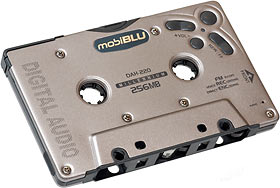
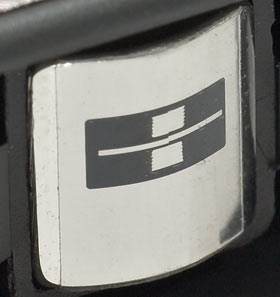
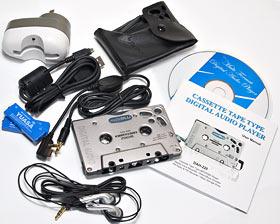
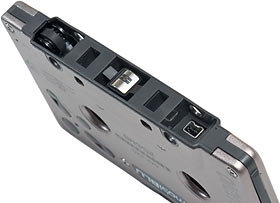
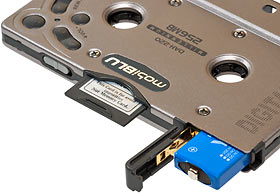
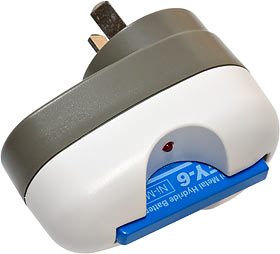
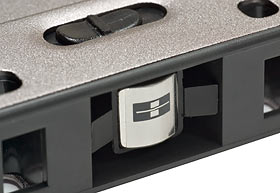
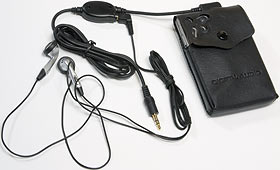

![[SecureWebs]](images/sw.gif)